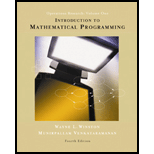
Introduction to mathematical programming
4th Edition
ISBN: 9780534359645
Author: Jeffrey B. Goldberg
Publisher: Cengage Learning
expand_more
expand_more
format_list_bulleted
Expert Solution & Answer
Chapter 2.1, Problem 4P
Explanation of Solution
Proving
Consider a matrix A of order
Thus, the matrix AB will be of the order
The matrix A has elements
Then, the element of D=AB will be of the form given below:
Transpose of this matrix is
And the element of the matrix
Now the transpose of the matrix B is
The element in
Expert Solution & Answer
Want to see the full answer?
Check out a sample textbook solution
Students have asked these similar questions
What is the difference of matrices M=(-1,0,-2)(0,-3,1) and N=(0,1,2)(0,0,-3)?
Consider the matrices below and find, if possible, the following: AB , BA, and AT+B
What is the sum of matrices M=(1,0,3)(0,-3,1) and N=(0,1,2)(0,0,-3)?
Chapter 2 Solutions
Introduction to mathematical programming
Ch. 2.1 - Prob. 1PCh. 2.1 - Prob. 2PCh. 2.1 - Prob. 3PCh. 2.1 - Prob. 4PCh. 2.1 - Prob. 5PCh. 2.1 - Prob. 6PCh. 2.1 - Prob. 7PCh. 2.2 - Prob. 1PCh. 2.3 - Prob. 1PCh. 2.3 - Prob. 2P
Ch. 2.3 - Prob. 3PCh. 2.3 - Prob. 4PCh. 2.3 - Prob. 5PCh. 2.3 - Prob. 6PCh. 2.3 - Prob. 7PCh. 2.3 - Prob. 8PCh. 2.3 - Prob. 9PCh. 2.4 - Prob. 1PCh. 2.4 - Prob. 2PCh. 2.4 - Prob. 3PCh. 2.4 - Prob. 4PCh. 2.4 - Prob. 5PCh. 2.4 - Prob. 6PCh. 2.4 - Prob. 7PCh. 2.4 - Prob. 8PCh. 2.4 - Prob. 9PCh. 2.5 - Prob. 1PCh. 2.5 - Prob. 2PCh. 2.5 - Prob. 3PCh. 2.5 - Prob. 4PCh. 2.5 - Prob. 5PCh. 2.5 - Prob. 6PCh. 2.5 - Prob. 7PCh. 2.5 - Prob. 8PCh. 2.5 - Prob. 9PCh. 2.5 - Prob. 10PCh. 2.5 - Prob. 11PCh. 2.6 - Prob. 1PCh. 2.6 - Prob. 2PCh. 2.6 - Prob. 3PCh. 2.6 - Prob. 4PCh. 2 - Prob. 1RPCh. 2 - Prob. 2RPCh. 2 - Prob. 3RPCh. 2 - Prob. 4RPCh. 2 - Prob. 5RPCh. 2 - Prob. 6RPCh. 2 - Prob. 7RPCh. 2 - Prob. 8RPCh. 2 - Prob. 9RPCh. 2 - Prob. 10RPCh. 2 - Prob. 11RPCh. 2 - Prob. 12RPCh. 2 - Prob. 13RPCh. 2 - Prob. 14RPCh. 2 - Prob. 15RPCh. 2 - Prob. 16RPCh. 2 - Prob. 17RPCh. 2 - Prob. 18RPCh. 2 - Prob. 19RPCh. 2 - Prob. 20RPCh. 2 - Prob. 21RPCh. 2 - Prob. 22RP
Knowledge Booster
Similar questions
arrow_back_ios
arrow_forward_ios
Recommended textbooks for you
 Operations Research : Applications and AlgorithmsComputer ScienceISBN:9780534380588Author:Wayne L. WinstonPublisher:Brooks Cole
Operations Research : Applications and AlgorithmsComputer ScienceISBN:9780534380588Author:Wayne L. WinstonPublisher:Brooks Cole

Operations Research : Applications and Algorithms
Computer Science
ISBN:9780534380588
Author:Wayne L. Winston
Publisher:Brooks Cole